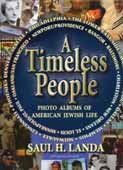A Timeless People
 A Timeless People
A Timeless People
By Saul Landa
Gefen Publishing House
Jerusalem, 2011
360 pages
Reviewed by Binyamin Ehrenkranz
In the twelfth century, a Spanish traveler known as Binyamin of Tudela set out on a thirteen-year tour of Jewish communities across Europe and the Middle East. He would later catalogue his sojourns in what would become a famous work—beyond which we know nothing of its author—disclosing vivid descriptions of Jews and their lifestyles. His writing focused mainly on the conditions of each community, discussing residents’ occupations, schools and hundreds of local leaders whom he had met. What this celebrated, mysterious writer did not know, however, was that his Massa’ot shel Rabbi Binyamin (Travels of Rabbi Benjamin) would anticipate another, perhaps equally engaging and certainly more illustrative work close to eight and a half centuries later: A Timeless People.
Saul Landa, a professor of dentistry at the University of Pennsylvania, had for some years moonlighted as a photojournalist for Jewish newspapers. In 2006, after attending the OU’s first Emerging Jewish Communities Fair in New York, Landa came up with the idea to take his camera on the road. Over the next four years he explored eighteen communities across four regions of the United States, a tour from which emerged this bold photo essay collection.
A rollicking Purim in bucolic Bangor, Maine, a Chanukah wedding in postcard-scenic Denver, a bar mitzvah alongside a Lag B’Omer bonfire in Minneapolis—each community is usually introduced in the context in which Landa’s arrival transpired. Then he gets to work, recounting nuggets of local history and the enduring hallmarks of each community’s culture. The book is richest, though, in its radiant and lively snapshots of Jewish life in action in places where many readers may not even have imagined existed.
Besides registering his personal observations and itinerary of celebrations, Landa also tells winsome stories gleaned from interviewing local elders, historians and community leaders, drawing the curtains for readers to press their noses against a wide window onto the past and present of each locale. And the lilt in his cross-country steps and memories reverberates as longtime residents and builders exude confidence about their respective communities’ future.
Phoenix’s rabbi and rebbetzin of nearly five decades, Rabbi David and Odette Rebibo, reflect heartily on their community’s progress. When they first arrived, a minyan on Shabbat was hard to come by. Today there’s a day school, multiple shuls, six kosher restaurants, three mikvaot and even a kollel.
Two years after Hurricane Katrina washed away the entire infrastructure of Jewish life in New Orleans, the community’s Jewish historian received a call from a rabbinic candidate, Rabbi Uri Topolosky. “Well, I said we have no shul,” recalls Irwin Lachoff. “We have no Torahs, we have nothing, and we’re probably not going to make it, but if you want to come down, okay. He did, and he took [the position]! The rabbi was our gift—our survival.”
The book excels in revealing the personal nature of communities and their beginnings, so much so that the amount of text may occasionally overwhelm the reader’s eye, given its coffee-table-book size. Unfortunately, the volume most likely cannot serve as an authoritative historical reference. In the entries on a few communities I am familiar with alone, I discovered several factual errors. (The book records the merging of two New York schools as happening in 1912, when it actually took place three years later. A woman whose family I know is reported to have been born in the community about which she’s interviewed, but she actually moved there when she was nineteen.) The author might also have considered focusing some of his efforts more on the historical development of community day schools, whose beginnings and founders in many instances are often not even alluded to.
Nonetheless, perhaps the book’s most important contribution is its reprinting in stunning quality historical photos and documents relating to each community’s founding and founders, and the interviewing of pioneers who still remember them. Ninety-seven-year-old Lillian Radinsky, recalling nascent communal life in Seattle, says: “We had Brenner Brothers Bakery and Ziegman, the butcher. Before every Yom Kippur, I was sent to choose a live chicken, feel it for its fat, and stand on line to have it slaughtered. I can still recall watching so many chickens running around the sawdust-covered wooden floors without their heads!”
Leadership figures also loom large along the way. After a visit to Milwaukee and its chief rabbi and son, Rabbis Michel and Benzion Twerski, Landa can’t help but be wistful upon leaving.
“When I was sitting at Reb Michel’s tisch [rebbe’s table] and listening to him softly singing, I realized that there is royalty here in Milwaukee. Not the kind of royalty that is separated from the people, but one intertwined with every Jewish soul.”
While it may not be a precise historical reference, A Timeless People’s blend of charming anecdotes, superb photography and engaging background on American communities of many kinds makes it a resource on modern American Jewry unlike any other available.
Binyamin Ehrenkranz is a copy editor for Jewish Action and serves on its Editorial Committee.
Hear an interview with Saul Landa about his book at www.ou.org/life/series/savitsky-talks/.
